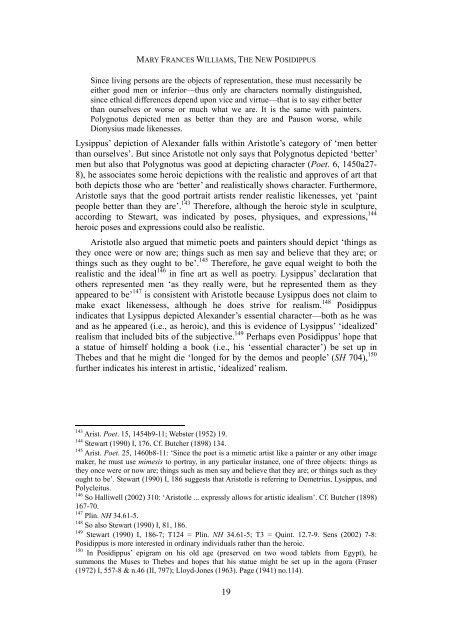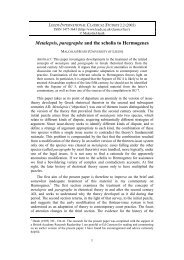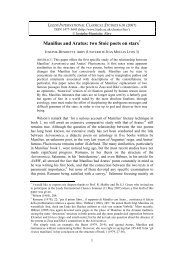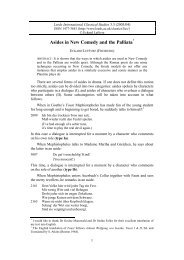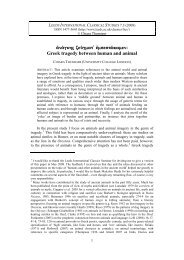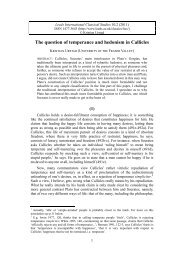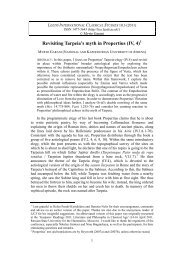The New Posidippus - Leeds International Classical Studies
The New Posidippus - Leeds International Classical Studies
The New Posidippus - Leeds International Classical Studies
Create successful ePaper yourself
Turn your PDF publications into a flip-book with our unique Google optimized e-Paper software.
MARY FRANCES WILLIAMS, THE NEW POSIDIPPUS<br />
Since living persons are the objects of representation, these must necessarily be<br />
either good men or inferior—thus only are characters normally distinguished,<br />
since ethical differences depend upon vice and virtue—that is to say either better<br />
than ourselves or worse or much what we are. It is the same with painters.<br />
Polygnotus depicted men as better than they are and Pauson worse, while<br />
Dionysius made likenesses.<br />
Lysippus’ depiction of Alexander falls within Aristotle’s category of ‘men better<br />
than ourselves’. But since Aristotle not only says that Polygnotus depicted ‘better’<br />
men but also that Polygnotus was good at depicting character (Poet. 6, 1450a27-<br />
8), he associates some heroic depictions with the realistic and approves of art that<br />
both depicts those who are ‘better’ and realistically shows character. Furthermore,<br />
Aristotle says that the good portrait artists render realistic likenesses, yet ‘paint<br />
people better than they are’. 143 <strong>The</strong>refore, although the heroic style in sculpture,<br />
according to Stewart, was indicated by poses, physiques, and expressions, 144<br />
heroic poses and expressions could also be realistic.<br />
Aristotle also argued that mimetic poets and painters should depict ‘things as<br />
they once were or now are; things such as men say and believe that they are; or<br />
things such as they ought to be’. 145 <strong>The</strong>refore, he gave equal weight to both the<br />
realistic and the ideal 146 in fine art as well as poetry. Lysippus’ declaration that<br />
others represented men ‘as they really were, but he represented them as they<br />
appeared to be’ 147 is consistent with Aristotle because Lysippus does not claim to<br />
make exact likenessess, although he does strive for realism. 148 <strong>Posidippus</strong><br />
indicates that Lysippus depicted Alexander’s essential character—both as he was<br />
and as he appeared (i.e., as heroic), and this is evidence of Lysippus’ ‘idealized’<br />
realism that included bits of the subjective. 149 Perhaps even <strong>Posidippus</strong>’ hope that<br />
a statue of himself holding a book (i.e., his ‘essential character’) be set up in<br />
<strong>The</strong>bes and that he might die ‘longed for by the demos and people’ (SH 704), 150<br />
further indicates his interest in artistic, ‘idealized’ realism.<br />
143<br />
Arist. Poet. 15, 1454b9-11; Webster (1952) 19.<br />
144<br />
Stewart (1990) I, 176. Cf. Butcher (1898) 134.<br />
145<br />
Arist. Poet. 25, 1460b8-11: ‘Since the poet is a mimetic artist like a painter or any other image<br />
maker, he must use mimesis to portray, in any particular instance, one of three objects: things as<br />
they once were or now are; things such as men say and believe that they are; or things such as they<br />
ought to be’. Stewart (1990) I, 186 suggests that Aristotle is referring to Demetrius, Lysippus, and<br />
Polycleitus.<br />
146<br />
So Halliwell (2002) 310: ‘Aristotle ... expressly allows for artistic idealism’. Cf. Butcher (1898)<br />
167-70.<br />
147<br />
Plin. NH 34.61-5.<br />
148<br />
So also Stewart (1990) I, 81, 186.<br />
149<br />
Stewart (1990) I, 186-7; T124 = Plin. NH 34.61-5; T3 = Quint. 12.7-9. Sens (2002) 7-8:<br />
<strong>Posidippus</strong> is more interested in ordinary individuals rather than the heroic.<br />
150<br />
In <strong>Posidippus</strong>’ epigram on his old age (preserved on two wood tablets from Egypt), he<br />
summons the Muses to <strong>The</strong>bes and hopes that his statue might be set up in the agora (Fraser<br />
(1972) I, 557-8 & n.46 (II, 797); Lloyd-Jones (1963). Page (1941) no.114).<br />
19


